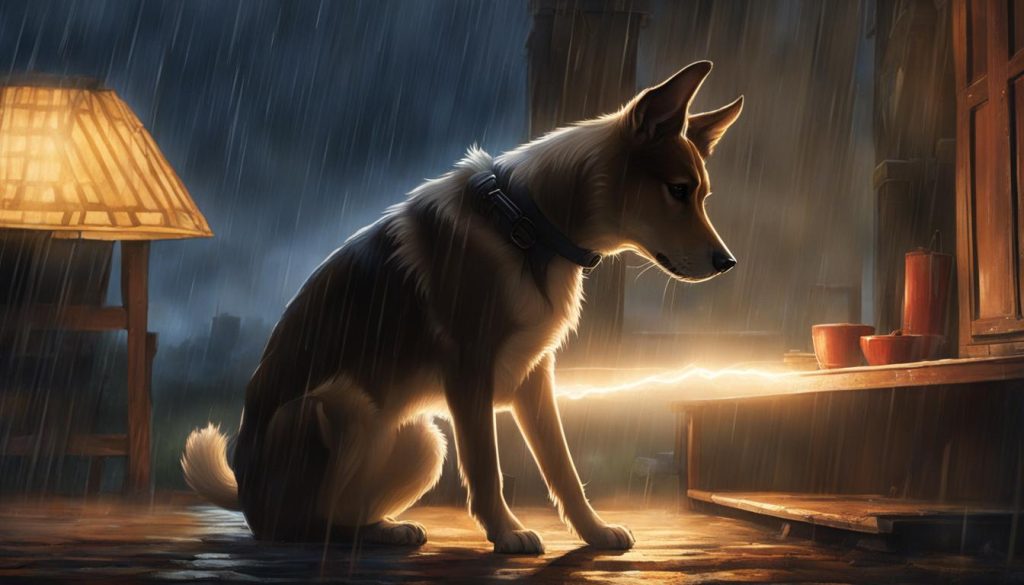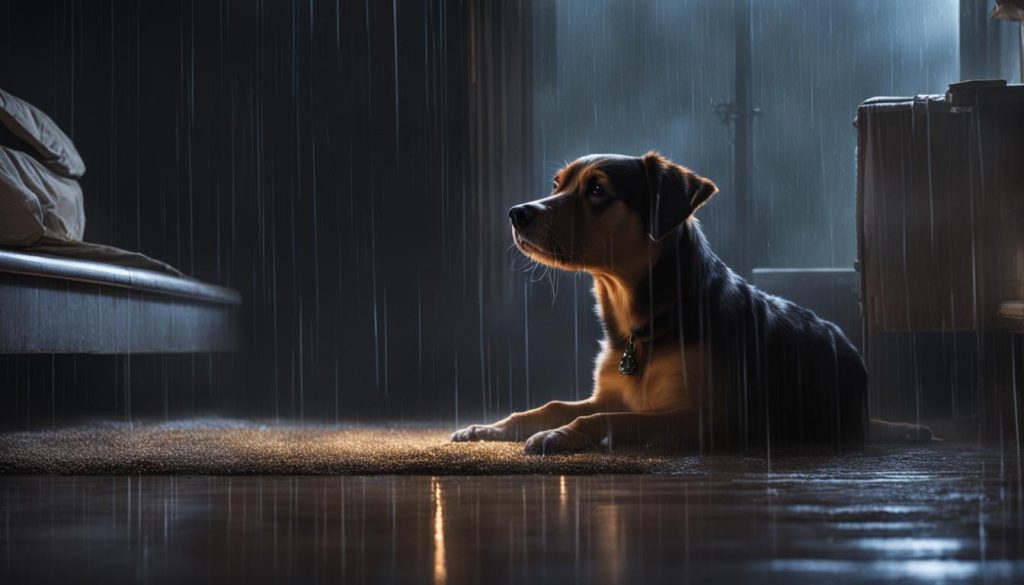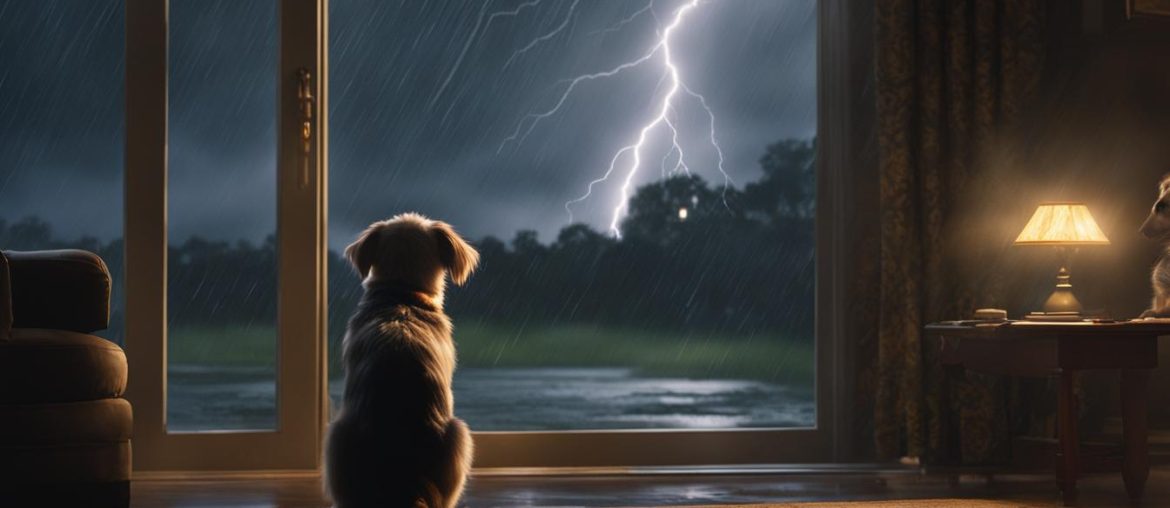Dogs can develop a fear of thunderstorms, known as thunder phobia, due to various factors. This fear can cause symptoms such as hiding, shaking, barking, and destructive behavior. The three main triggers for this fear are canine noise aversion, separation anxiety, and static electricity. Thunderstorms can generate static electricity, which can cause discomfort or even mild shocks for dogs with long or double coats. It is estimated that around 40% of dogs experience noise anxiety, which can worsen with regular exposure. While certain dog breeds may be genetically predisposed to noise phobias, dogs of all ages can develop this fear.
Key Takeaways:
- Dogs can develop a fear of thunderstorms, known as thunder phobia.
- The three main triggers for this fear are canine noise aversion, separation anxiety, and static electricity.
- Thunderstorms can cause discomfort or mild shocks for dogs with long or double coats.
- Around 40% of dogs experience noise anxiety.
- Dogs of all ages can develop a fear of thunderstorms, regardless of breed.
Causes of Canine Noise Aversion

The causes of canine noise aversion, including fear of thunderstorms, can be complex. Various factors contribute to this fear and anxiety in dogs.
- Drop in barometric pressure: A decrease in barometric pressure that often occurs before a storm can trigger fear and uneasiness in dogs. They may sense this change in atmospheric pressure and perceive it as a potential threat.
- Dark clouds and thunder: The visual cues of dark clouds and the loud crash of thunder can create significant distress for dogs. These sensory stimuli can trigger their fear response, leading to anxiety and unease.
- Sound of thunder and lightning: The loud and sudden noises produced by thunderstorms, including thunder and lightning, can be terrifying for dogs. The loud booms and flashes of light can startle and overwhelm them, contributing to their fear and anxiety.
- Low-frequency rumbles: The low-frequency rumbles that often precede a storm can also contribute to canine noise aversion. These deep rumbles can be unsettling for dogs, heightening their anxiety and fear.
- Static electricity buildup: During a thunderstorm, static electricity can build up in a dog’s coat. This static buildup can cause discomfort or even mild shocks, exacerbating their fear and anxiety during thunderstorms.
Dogs experiencing noise aversion may exhibit a range of symptoms, including trembling, pacing, panting, and restlessness.
Canine Noise Phobia and Genetics

Certain dog breeds, such as border collies and Australian shepherds, may have a genetic predisposition to developing noise phobias. Annual surveys suggest that noise sensitivity and phobia are prevalent in these breeds, with estimates as high as 40%. However, noise phobias can also develop in dogs of all breeds and ages. The reasons for these genetic predispositions are not fully understood, but it is believed that certain traits and temperament characteristics may contribute to increased susceptibility.
It’s important to recognize that thunderstorm fear in canines is not solely determined by genetics. While certain breeds may have a higher likelihood of developing thunder phobia, dogs of all backgrounds can experience this fear. Environmental factors, past experiences, and individual differences can also contribute to the development and severity of thunderstorm anxiety in dogs.
Understanding the genetic aspect of canine noise phobia is valuable as it helps us identify potential risk factors. By knowing that certain breeds may be more prone to thunder phobia, dog owners and breeders can take proactive measures to provide appropriate training, socialization, and support to mitigate fear and anxiety.
The Role of Genetics in Thunder Phobia
When it comes to thunder phobia, genetics can play a significant role in increasing a dog’s susceptibility to developing this fear. Certain breeds may possess genes that make them more sensitive to loud noises and fearful situations, such as thunderstorms. The presence of these genes, combined with environmental factors, can contribute to the manifestation of thunder phobia in susceptible individuals.
“Genetic predisposition doesn’t mean that every dog of a specific breed will develop thunder phobia. It simply means that certain breeds might have a higher chance of experiencing it. Environmental factors and individual differences also play a crucial role in the development and severity of thunderstorm anxiety.” – Dr. Emily Collins, Canine Behavior Specialist
Environmental Factors and Dog Thunder Phobia
While genetics can contribute to a dog’s predisposition to thunder phobia, environmental factors also play a crucial role. Traumatic experiences during thunderstorms, such as previous exposure to loud noises or negative associations, can intensify a dog’s fear. Additionally, dogs that lack proper socialization and enrichment may be more susceptible to developing anxiety and phobias.
It’s important to create a safe and secure environment for dogs during thunderstorms. This includes providing them with a designated safe space where they can seek refuge, such as a crate or a quiet room. Calming aids, such as thundershirts or pheromone diffusers, can also help alleviate fear and anxiety.
The Importance of Early Intervention
Recognizing the potential genetic predisposition to thunder phobia and addressing it early is vital for a dog’s well-being. Puppy socialization and exposure to various sights, sounds, and experiences can help desensitize them to potentially frightening stimuli like thunderstorms. Early intervention through positive reinforcement training, behavioral modification techniques, and gradual exposure can help prevent or minimize the development of thunder phobia.
Separation Anxiety and Thunder Phobia

Separation anxiety can play a significant role in exacerbating a dog’s thunder phobia. When dogs are highly anxious or distressed when separated from their owners, their fear of thunderstorms can intensify. The presence of their owner during a storm provides a sense of comfort and security for the dog, helping to alleviate their anxiety. However, dogs who don’t typically exhibit signs of separation anxiety may experience increased distress due to the unfamiliar and uncomfortable changes caused by a thunderstorm. It is crucial to address both the thunder phobia and separation anxiety to help the dog cope with the fear and anxiety associated with storms.
During a thunderstorm, the dog may seek out their owner for reassurance and protection. The close proximity to their owner helps to provide a sense of safety and stability, reducing the dog’s overall anxiety levels. The owner’s comforting presence can be a source of comfort and can help distract the dog from their fear of the thunderstorm. However, it’s important to note that excessively comforting the dog can reinforce their fear and anxiety, so it’s essential to strike a balance between providing support and maintaining a sense of normalcy.
In cases where a dog exhibits signs of separation anxiety during thunderstorms, it may be beneficial to implement strategies to help address this condition. Gradual desensitization and counter-conditioning techniques can be effective in reducing separation anxiety in dogs. These techniques involve gradually exposing the dog to short periods of separation during thunderstorms, starting with very brief intervals and gradually increasing the duration over time. This gradual exposure helps the dog build confidence and develop coping mechanisms to manage their anxiety.
Remember to consult with a professional, such as a veterinarian or animal behaviorist, for guidance and personalized advice on addressing your dog’s separation anxiety and thunder phobia. They can provide a comprehensive treatment plan tailored to your dog’s specific needs.
In addition to behavior modification techniques, there are also calming aids and supplements that can help alleviate separation anxiety and thunder phobia in dogs. These include pheromone diffusers or sprays, which emit synthetic versions of calming pheromones naturally produced by mother dogs to comfort their puppies. These synthetic pheromones can help reduce anxiety and promote a sense of calmness in dogs. Anti-anxiety medications may also be prescribed in severe cases, but these should always be used under the guidance and supervision of a professional.
By addressing both separation anxiety and thunder phobia, dog owners can help their furry companions better cope with the fear and anxiety associated with thunderstorms. Providing a safe and secure environment, along with appropriate behavioral interventions and, if necessary, professional guidance, can make a significant difference in helping the dog feel more comfortable and secure during thunderstorms.
Coping Strategies for Dogs with Thunder Phobia

When it comes to helping dogs cope with thunder phobia, there are several effective strategies that can be implemented. By understanding and addressing their fears, we can provide them with the support they need to navigate through thunderstorms.
Creating a Safe Space
The first step in helping your dog cope with thunder phobia is to allow them to choose a safe space where they feel secure during a storm. This can be a confined area such as the basement or a small room, where they can retreat and find comfort.
Minimizing Noise
Creating a comfortable environment in this safe space is crucial. Adding white noise or soundproofing can help block or minimize the sound of thunder, making the space more soothing for your dog. This can be done by using a fan, a radio playing soft music, or a white noise machine.
Anti-Static Jackets
Anti-static jackets, such as the Anxiety Wrap, have been found to be effective in relieving stress and anxiety during thunderstorms. These specially designed wraps apply gentle pressure to your dog’s body, which can have a calming effect and reduce their fear response.
Behavioral Modification Techniques
Behavioral modification techniques, including counter-conditioning and desensitization, can be used to reduce fear and anxiety over time. These techniques involve gradually exposing your dog to the sound of thunder in a controlled and positive way, allowing them to associate it with something pleasant rather than fear.
Consulting with a Veterinarian
If your dog’s thunder phobia is severe or persists despite your efforts, it is recommended to consult with a veterinarian. They may prescribe anti-anxiety medication to help alleviate your dog’s fear and anxiety. However, medication should always be used under professional guidance and as a last resort.
Remember, every dog is unique, and what works for one may not work for another. It’s important to be patient, consistent, and understanding as you help your furry friend overcome their fear of thunderstorms.
Understanding the Fear Response in Dogs

Dogs exhibit various signs of fear and anxiety during thunderstorms. Common behaviors include hiding, whining, panting, drooling, and destructive behavior. These reactions are a natural fear response to perceived threats. It’s important for dog owners to understand how to support their furry friends during these challenging times.
When dogs are scared of thunderstorms, it’s crucial not to punish or excessively comfort them. Punishment can worsen their fear and reinforce the belief that the storm is indeed dangerous. On the other hand, excessive comforting can inadvertently validate their fears. Instead, it’s best to remain calm and act normally, providing a sense of security for the dog.
Creating a positive association with thunderstorms can help shift your dog’s emotional response to the event. Engaging in activities like playing with their favorite toys or engaging in training sessions during a storm can divert their attention and create a more positive experience. These activities can help distract your dog from their fear and promote a more relaxed state of mind.
Maintain a Calm Environment
One of the most effective ways to help dogs overcome their fear of thunderstorms is to maintain a calm environment. Behavior experts recommend minimizing external stimuli by closing windows, curtains, and blinds to reduce the visual and auditory impact of the storm. Playing soft, soothing music or white noise can also help drown out the noise of thunder and lightning.
Additionally, creating a safe and comfortable space for your dog to retreat to during thunderstorms can provide them with a sense of security. This can be a designated area in the house, such as a bathroom or under a bed, where your dog feels safe and protected. Make sure to provide soft bedding and familiar items to help them feel more at ease.
The Power of Positive Reinforcement
Positive reinforcement techniques can be powerful tools in helping dogs overcome their fear of thunderstorms. By associating the storm with positive experiences, you can help shift their emotional response. For example, giving treats or engaging in playtime during a storm can help create positive associations and reduce their anxiety.
“Reward-based training and positive reinforcement techniques can be highly effective in reshaping a dog’s response to thunderstorms and reducing their fear.” – Dr. Laura Johnson, Veterinary Behaviorist
Training your dog to perform a specific task or behavior during a storm can provide them with a sense of purpose and distraction. This can include simple commands like sit, stay, or paw. The engagement and focus required for these tasks can divert their attention away from the fear-inducing elements of the storm.
Image: Understanding the Fear Response in Dogs
Summary
Understanding the fear response in dogs is crucial for helping them cope with thunderstorms. Punishment and excessive comforting should be avoided, as they can worsen the fear and reinforce negative associations. Instead, remaining calm, creating a positive environment, and utilizing positive reinforcement techniques can help shift your dog’s emotional response to thunderstorms. By providing support and a sense of security, you can help your furry friend navigate through their fear and anxiety, ultimately improving their overall well-being during storms.
Home Remedies for Thunder Phobia

When thunderstorms strike, it’s essential to have effective home remedies at hand to help calm your dog and alleviate their thunder phobia. Here are some remedies that can provide comfort and security during stormy weather:
- Provide a Safe Hiding Spot: Creating a cozy sanctuary for your dog can make them feel protected and secure. Set up a space in a bathroom or tucked away under a bed where they can retreat during thunderstorms.
- Create a Comfortable Environment: Make the hiding spot even more inviting by dimming the lights and adding soft bedding. This can help create a sense of security and relaxation for your furry friend.
- Utilize Calming Sounds: Using white noise machines or playing soothing music can help drown out the sound of thunder and create a calming atmosphere. Additionally, pheromone products like Adaptil, which mimic the natural appeasing pheromones produced by mother dogs, can help soothe anxiety in dogs.
- Consider Antistatic Jackets and Wrappings: These specialized garments can help reduce static electricity buildup in your dog’s fur, providing a sense of comfort and ease their anxiety during storms.
- Massage Techniques: The TTouch method, a gentle touch and massage technique, can help relax dogs during thunderstorms. It involves circular motions and light pressure on specific points of the body to release tension and promote relaxation.
- Explore Calming Foods and Supplements: Certain pet foods and supplements containing ingredients like chamomile, valerian root, or CBD can have calming effects on dogs. It’s important to consult with a veterinarian before introducing any new dietary supplements.
By implementing these home remedies, you can create a soothing and secure environment for your dog during thunderstorms, helping them manage their thunder phobia. Remember, every dog is unique, so it’s essential to find the remedies that work best for your furry companion.
| Home Remedies for Thunder Phobia | Benefits |
|---|---|
| Providing a safe hiding spot | Gives your dog a secure space to retreat and feel protected. |
| Creating a comfortable environment | Dimming the lights and adding soft bedding enhances the sense of security and relaxation. |
| Utilizing calming sounds | White noise machines and soothing music can drown out thunder sounds and create a calming atmosphere. |
| Consider antistatic jackets and wrappings | Reduces the effects of static electricity in the dog’s fur, providing comfort during storms. |
| Massage techniques | TTouch method can help release tension and promote relaxation in dogs. |
| Exploring calming foods and supplements | Certain ingredients in pet foods and supplements have calming effects on dogs. |
Seeking Professional Help for Thunder Phobia
If the dog’s thunder phobia persists or worsens, it’s advisable to seek professional help from an animal behaviorist or veterinarian. They can provide guidance on behavior modification techniques and prescribe anti-anxiety medications if necessary. Anti-anxiety medications can help alleviate the dog’s fear and improve their quality of life. It’s important to consult with a professional before relying on medication as the first line of treatment. Behavioral modification techniques, such as counter-conditioning and desensitization, should be explored first to address the underlying fear and anxiety.
Behavioral Modification Techniques
Behavioral modification techniques are a crucial aspect of managing thunder phobia in dogs. These techniques aim to change the dog’s emotional response to thunderstorms and reduce fear and anxiety levels. One common technique is counter-conditioning, which involves pairing the presence of a thunderstorm with positive experiences. This can be achieved by offering treats or engaging in enjoyable activities during a storm. Desensitization is another technique that involves gradually exposing the dog to the sound of thunder at a low volume and gradually increasing it over time. This helps the dog develop tolerance and reduces their fear response.
“A professional can guide you through the process of behavior modification and ensure that it is tailored to your dog’s individual needs.”
| Treatment Options | Pros | Cons |
|---|---|---|
| Behavioral Modification Techniques | – Can address the underlying fear and anxiety | – Requires time, patience, and consistency |
| Anti-Anxiety Medications | – Can provide short-term relief | – May cause side effects |
Consulting with an Animal Behaviorist or Veterinarian
When seeking professional help for thunder phobia, it’s essential to consult with an animal behaviorist or veterinarian experienced in treating fear and anxiety in dogs. They will assess your dog’s individual needs and develop a customized treatment plan. This may include a combination of behavioral modification techniques and, if necessary, the prescription of anti-anxiety medications. A professional can guide you through the process of behavior modification and ensure that it is tailored to your dog’s individual needs.
Long-Term Management of Thunder Phobia
Thunder phobia is a condition that can greatly impact a dog’s well-being. To help your furry friend cope with their fear and anxiety, a long-term approach to management is often necessary.
One effective strategy is to create a safe space where your dog can seek refuge during thunderstorms. This can be a designated area in your home, such as a bathroom or a small room, where they feel secure and protected. Fill this space with familiar items, such as their favorite toys, blankets, or bedding, to provide comfort.
Calming aids can also be useful in managing thunder phobia. Consider using products like pheromone diffusers or sprays, calming music or white noise machines, or even an anti-static jacket for added comfort. These aids can help create a soothing environment and reduce your dog’s anxiety during storms.
Implementing behavioral modification techniques can also be beneficial in the long-term management of thunder phobia. One technique is counter-conditioning, which involves pairing the sound of thunder with positive experiences. For example, you can offer your dog treats or engage them in a fun activity whenever thunder occurs, gradually associating the sound with something positive.
Seeking professional guidance from a veterinarian or animal behaviorist is highly recommended for effective long-term management. They can provide personalized advice, additional strategies, and, if necessary, prescribe medication to help alleviate your dog’s fear and anxiety. Medication should be used under professional supervision and as part of a comprehensive treatment plan.
Consistency and patience are key when managing thunder phobia in the long term. Each dog is unique, and it may take time to find the most effective combination of strategies that work for your furry friend. With proper care and attention, dogs can become more resilient and less fearful during thunderstorms, leading to a better quality of life for both you and your canine companion.
Wrapping Up
Thunder phobia in dogs is a complex condition that can be caused by various factors, including noise aversion, separation anxiety, and static electricity. Understanding the triggers and underlying causes of the fear can help dog owners develop effective strategies to manage and alleviate the phobia. From creating a safe space for the dog to using calming aids and implementing behavioral modification techniques, there are multiple approaches to help dogs overcome their fear of thunderstorms. Seeking professional help, if needed, can provide additional support and guidance. With patience and consistency, dogs can learn to cope with their fear and anxiety, leading to a better quality of life during thunderstorms.
FAQ
Why are dogs scared of thunder?
Dogs can be scared of thunder due to a condition known as thunder phobia. This fear can be caused by factors such as canine noise aversion, separation anxiety, and static electricity. Thunderstorms can generate static electricity, leading to discomfort or mild shocks for dogs with long or double coats. The sound of thunder and the unfamiliar changes caused by a storm can trigger fear and anxiety in dogs.
What are the causes of canine noise aversion?
The causes of canine noise aversion, including fear of thunderstorms, can be complex. A drop in barometric pressure, dark clouds, and the crash of thunder can trigger fear and anxiety in dogs. The sound of thunder, lightning, and low-frequency rumbles that precede a storm can also contribute to this fear. Additionally, static electricity buildup in the dog’s coat during a storm can lead to discomfort or mild shocks, exacerbating their fear. Dogs with noise aversion may exhibit symptoms such as trembling, pacing, panting, and restlessness.
Are certain dog breeds more prone to thunder phobia?
Certain dog breeds, such as border collies and Australian shepherds, may have a genetic predisposition to developing noise phobias. Annual surveys suggest that noise sensitivity and phobia are prevalent in these breeds, with estimates as high as 40%. However, noise phobias can also develop in dogs of all breeds and ages. The reasons for these genetic predispositions are not fully understood, but it is believed that certain traits and temperament characteristics may contribute to increased susceptibility.
How does separation anxiety contribute to thunder phobia?
Separation anxiety, a condition where dogs become highly anxious or distressed when separated from their owners, can exacerbate thunder phobia. The presence of their owner during a storm can provide comfort and security for the dog. The unfamiliar and uncomfortable changes caused by a thunderstorm can trigger separation anxiety in dogs who don’t typically exhibit signs of this condition. It’s important to address both the thunder phobia and separation anxiety to help the dog cope with the fear and anxiety associated with storms.
What are some strategies to help dogs cope with thunder phobia?
There are various strategies to help dogs cope with thunder phobia. The first step is to allow the dog to choose a safe space where they feel secure during a storm. This can be a confined area like the basement or a small room. Creating a comfortable environment in this safe space, such as adding white noise or soundproofing, can help block or minimize the sound of thunder. Anti-static jackets, like the Anxiety Wrap, have been found to be effective in relieving stress and anxiety during thunderstorms. Behavioral modification techniques, such as counter-conditioning and desensitization, can also be used to reduce fear and anxiety over time.
What are the signs of fear and anxiety in dogs during thunderstorms?
Dogs exhibit various signs of fear and anxiety during thunderstorms, including hiding, whining, panting, drooling, and destructive behavior. These reactions are a natural fear response to perceived threats. It’s important to understand that punishing or excessively comforting a fearful dog can worsen their fear and reinforce the belief that the storm is dangerous. Instead, it’s best to remain calm and act normally, providing a sense of security for the dog. Creating a positive association with thunderstorms through activities like providing their favorite toys or engaging in training can help shift their emotional response to the event.
What are some home remedies for thunder phobia?
There are several home remedies that can help dogs during thunderstorms. Providing a safe and cozy hiding spot for the dog, such as a bathroom or under a bed, can help them feel protected. Creating a dark and comfortable environment with soft bedding can also offer a sense of security. Using white noise machines, soothing music, or pheromone products like Adaptil can help calm the dog’s nerves. Antistatic jackets and wrappings, while their effectiveness may vary, can provide a sense of comfort. Massage techniques such as the TTouch method can help relax dogs during storms. Additionally, certain pet foods and supplements may have calming effects and can be discussed with a veterinarian.
When should I seek professional help for thunder phobia?
If the dog’s thunder phobia persists or worsens, it’s advisable to seek professional help from an animal behaviorist or veterinarian. They can provide guidance on behavior modification techniques and prescribe anti-anxiety medications if necessary. Anti-anxiety medications can help alleviate the dog’s fear and improve their quality of life. It’s important to consult with a professional before relying on medication as the first line of treatment. Behavioral modification techniques, such as counter-conditioning and desensitization, should be explored first to address the underlying fear and anxiety.
How can thunder phobia be managed in the long term?
Thunder phobia may require long-term management to help the dog cope with their fear and anxiety. This can involve a combination of strategies, including creating a safe space, using calming aids, implementing behavioral modification techniques, and seeking professional guidance. It’s important for dog owners to be patient and consistent in their approach to managing thunder phobia. Over time, with proper care and attention, dogs can become more resilient and less fearful during thunderstorms.
Is thunder phobia a common condition?
Thunder phobia in dogs is a complex condition that can be caused by various factors. It is estimated that around 40% of dogs experience noise anxiety, which can worsen with regular exposure. While certain dog breeds may be genetically predisposed to noise phobias, dogs of all ages can develop this fear. Understanding the triggers and underlying causes of the fear can help dog owners develop effective strategies to manage and alleviate the phobia.






